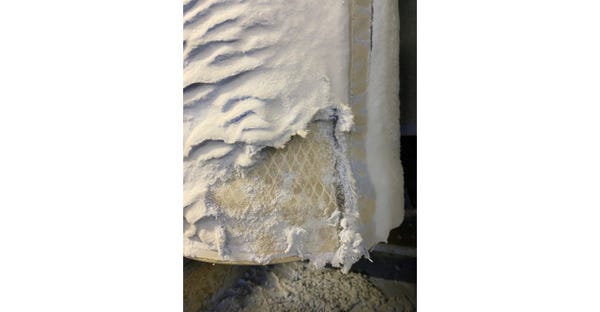Solutions for Dealing with Tough and Challenging Dusts
The first step in finding a dust filtration solution that works best for your operation is understanding the type of dust you are dealing with.
June 27, 2023

Patrick Stumpf, product manager, Donaldson Company, Inc.
Working with materials that create sticky or agglomerative dust can be a headache. Many types of dust can clog ordinary filters, slowing efficiency and productivity. You may even experience back-ups that fill your plant with dust. To help prevent the downtime and hours of clean-up caused by a clogged filtration system, it is worth exploring dust control solutions specifically designed to handle challenging dust.
Identifying Challenging Dust
A challenging dust is defined as one that is difficult to remove from the filter during cleaning and difficult to remove from the dust collector. Its characteristics include:
Stickiness
Moist
Agglomerative
Light dusts
Heavy dust loading
Sub-micron particulate size
Uniform particulate size
Any combination of the above
A wide range of materials can generate challenging dust including food ingredients (such as flour and sugar), salt and salt mixes, concrete with moisture, pet food and livestock feedstuffs, and many others. Depending on the type of dust your operation generates, you may notice the following filtration issues:
Sticky and agglomerative dusts: Often have the tendency to create dust cakes that harden and/or cling to the filter, making the dust cake difficult to knock down during pulse cleaning. Sticky dusts can also build up within the dust collector, reducing the cleaning efficiency of the unit and preventing dust from flowing down and out of the unit.
Light and fluffy dusts: Can also “re-entrain” on the duct collector filters during cleaning, where the filter is never fully cleaned since it constantly re-absorbs the dust from the filter that was just cleaned. In upward flowing dust collectors, light dusts may not be able to overcome the force of the airflow and will remain suspended, eventually building up around the tube sheet and filters.
Small, uniform dusts: Can depth load media and create a strong, consistent dust cake that is difficult to handle.

Filtration Techniques to Combat Challenging Dust
Processors and manufacturers have learned through the years that certain filtration features do a better job of capturing challenging dust and maintaining consistent airflow with less clogging and fewer slowdowns. Here are some proven features to consider when trying to solve for sticky situations:
1. High Inlet with Downflow Air Pattern
Coming in high and exiting low creates a downward airflow pattern that helps push dust down and out of the dust collector through the hopper.
2. Optimized Inlet with Baffle Plates
A dust collector’s inlet size and shape determine the flowrate and distribution of air throughout the dust collector. Using computational fluid dynamics (CFD), a dust collector’s inlet size and shape can be optimized for the airflow volume it is intended to handle, thereby evenly distributing air over the filter elements. Inlet baffles can also be present and assist by knocking down larger particulate while evenly distributing the dust laden air over the filters, resulting in longer filter life.
3. Envelope-Style Filters for Better Cleaning
Filter shape also plays a significant role in the dust collector’s ability to dislodge the built-up dust cake during pulse cleaning. Envelope-shaped filter bags allow for significantly more filter displacement during pulse cleaning in comparison to traditional round or oval shaped filter bags. The displacement and “snap” of the filter bags during pulse cleaning results in a strong cleaning performance against challenging and sticky dusts that isn’t possible in traditional baghouse dust collectors.
4. Enhanced (Optimized) Pulse-Cleaning System
A dust collector is better able to remove dust from the filters when the pressure and duration of its “pulse” have been studied and optimized to deliver the pulse evenly throughout the filter.
5. Increased Spacing Between Filters for Better Dust Dropout
More space between filters allows dust to travel down and out of the dust collector more easily. The additional space between filters also helps minimize dust re-entrainment by providing a buffer between a filter that is being pulse cleaned and adjacent filters; the buffer space makes its less likely that suspended dust will be captured by filters next to the filter that has just been cleaned.
6. Minimal Ledge Design
Dust collectors with significant interior ledges or structures can cause dust to build up on/around them, leading to a degradation in collector performance over time and required maintenance to clean the unit. The opposite is also true: Collectors with limited ledges and sloped surfaces minimize material build up within the unit.
7. Hopper and Hopper Outlet Design
The shape and outlet size of a dust collector has significant influence on moving material down and out of the unit. A steeply designed hopper (60-degree angles) limits the frictional force and allows gravity to promote movement of captured particulate downward. A larger hopper outlet size also increases the area for captured particulate to move through. The steeper the hopper and the larger the hopper outlet, the easier it is to move particulate out of the collector.
8. Modular Design
A collector that can be built modularly also provides a variety of benefits. By going to a shorter and wider unit with multiple inlets, dust can be more evenly distributed across the filter elements. A collector with multiple inlets also allows process owners to slow down the air entering the unit which can reduce filter abrasion and extend filter life.
Know Your Challenge
The first step in finding a dust filtration solution that works best for your operation is understanding the type of dust you are dealing with. Then a trained professional can work with you to configure a system that addresses your specific situation – even if it includes tough and challenging dust.
Patrick Stumpf is product manager, Donaldson Company, Inc. (Bloomington, MN). For more information, call 952-887-3131 or visit www.donaldson.com/en-us.
You May Also Like


